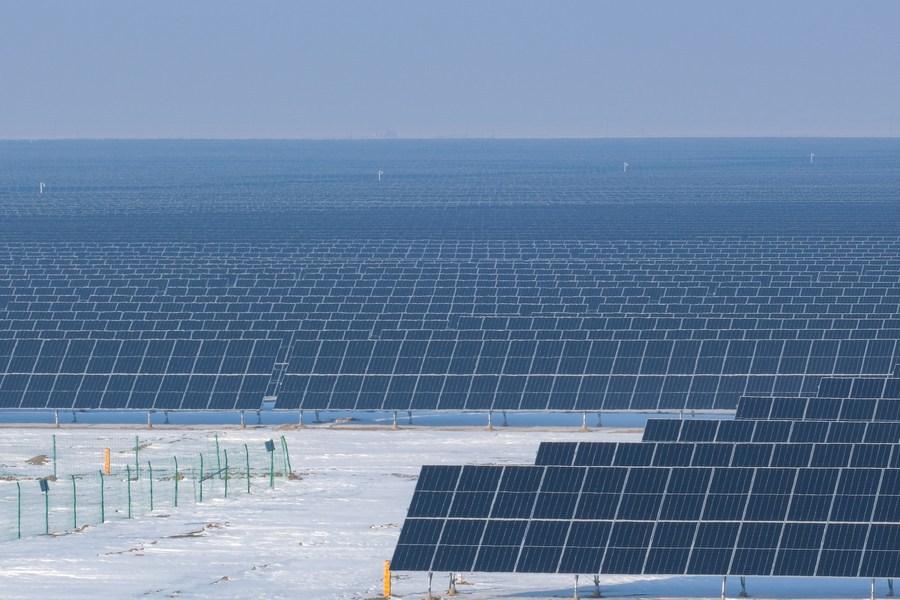
 0 Comment(s)
0 Comment(s) Print
Print E-mail China.org.cn, March 7, 2024
E-mail China.org.cn, March 7, 2024Three national political advisors have jointly initiated a proposal that calls for the establishment of a regional science and technology innovation center in the Xinjiang Uygur Autonomous Region, aiming to advance the development of Central Asia.

A photovoltaic power project is shown in the Kazak Autonomous County of Mori, Changji Hui Autonomous Prefecture, northwest China's Xinjiang Uygur Autonomous Region. [Photo/Xinhua]
During the ongoing second session of the 14th National Committee of the Chinese People's Political Consultative Conference (CPPCC), Liang Yong, a member of the 14th CPPCC National Committee and a local official responsible for the development of the cotton industry in Xinjiang, together with two other political advisors, Deng Mingjiang, an academician of the Chinese Academy of Engineering, and Xiao Wenjiao, a fellow of the Chinese Academy of Sciences, co-signed the proposal.
In the proposal, they requested that relevant national departments include the development of a science and technology innovation center in Xinjiang, aimed at benefiting Central Asia, into the regional science and technology innovation system.
Citing the Outline of the 14th Five-Year Plan (2021-2025) for National Economic and Social Development and the Long-Range Objectives Through the Year 2035, which supports the construction of regional science and technology innovation centers in suitable locations, they highlighted Xinjiang's significant geographical advantages. They argued that establishing such a center in Xinjiang, aimed at Central Asia, aligns with the Belt and Road Initiative. This move would fully utilize Xinjiang's unique geographical position and the benefits of its free trade pilot zone, fostering technological cooperation and economic exchanges with Central Asian countries. This would help Xinjiang develop and better integrate into China's broader strategy of westward opening-up. It would also help Xinjiang attract diverse, innovative resources from within China and around the world, such as technologies, skilled professionals and projects. This would enhance Xinjiang's scientific and technological innovation capabilities, support its technological self-reliance, and promote regional coordinated development.
They recommended focusing on Xinjiang's strategic positioning and optimizing its layout in scientific and technological innovation. They called for tailored reform policies and support measures from the Ministry of Science and Technology and other relevant departments to address areas such as talent, taxation, funding for science and technology, enterprises, and intellectual property rights. Their goal is to encourage innovation-driven development along the Silk Road Economic Belt, including building specialized industrial innovation centers in Xinjiang that would benefit key cities in both southern and northern Xinjiang, as well as partner countries in Central Asia, thus facilitating cross-regional coordinated development.
They also proposed enhancing the coordination mechanism for scientific and technological assistance to Xinjiang. Moreover, they urged reciprocal scientific and technological cooperation with Central Asian countries, participation in the national Belt and Road science and technology innovation action plan, pragmatic and in-depth exchanges, and cooperation in various fields. This would include the establishment of a China-Central Asia scientific and technological innovation community. These efforts would provide technological support for constructing the China-Central Asia-West Asia Economic Corridor and enhance the well-being of both Xinjiang and the Central Asian regions.
Furthermore, they suggested establishing a government-led, multi-channel scientific and technological investment model that includes diversified crowdfunding and innovating the financial mechanism for scientific and technological investment. Additionally, they recommended implementing a national-level talent assistance project to provide intellectual support for enhancing Xinjiang's development momentum.
Xinjiang is home to national-level research institutes, universities with strong research capabilities, and 12 state-level bases for international sci-tech cooperation. The region excels in equipment manufacturing, coal chemicals, mineral resources, new materials, modern agriculture, and pharmaceutical R&D. Xinjiang is a global leader in technologies like ultra-low wind speed turbines and photovoltaic power station integration. The region leads the nation in various technologies, including solar and wind energy, dry air energy, high-voltage electrical transmission, oil and gas exploration, and cotton cultivation.
"Xinjiang and Central Asia possess clear complementary advantages in industrial cooperation. There are broad prospects for scientific and technological cooperation in areas such as water resource utilization, mineral development, green energy, modern agriculture, ecological protection, and healthcare. These have made Xinjiang a hub of industrial and technological innovation in Central Asia. The region's technological accumulation has already established significant scientific and technological advantages for Central Asia, providing a solid foundation for international scientific and technological cooperation with evident outward effects," said Liang Yong, also a member of the China Association for Promoting Democracy. He also advocated the establishment of a cotton common market within the Shanghai Cooperation Organization (SCO) in another one of his proposals during this year's "two sessions."
Go to Forum >>0 Comment(s)